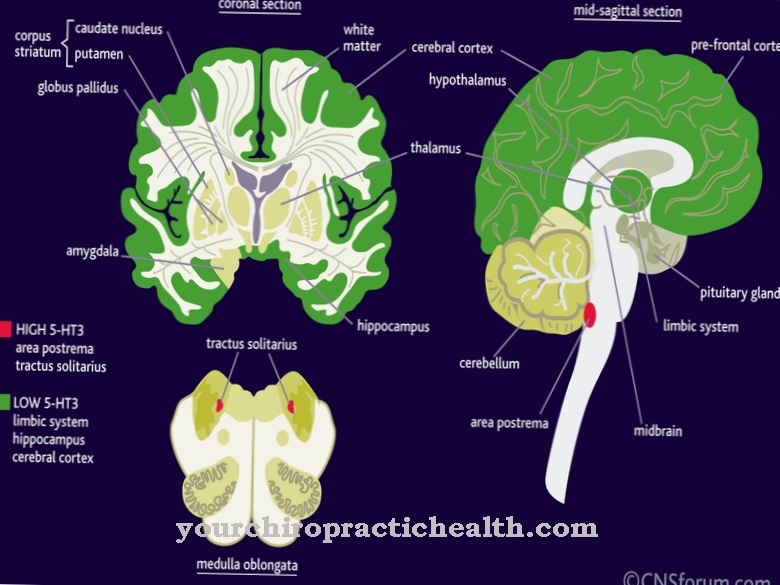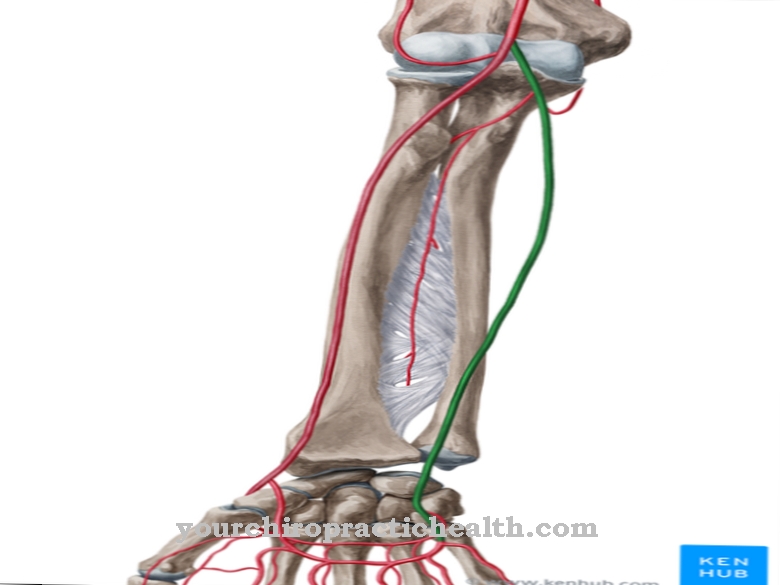The Corpus mamillare is a structure in the diencephalon (diencephalon) and forms part of the limbic system. It is also the origin of the mamillothalamic tract and the mamillotegmental tract. Damage to the corpus mamillare can lead to impaired memory.
What is the corpus mamillare?
The corpus mamillare is located in the diencephalon as part of the hypothalamus. It is also called because of its shape Nipple body known and is located between the two cerebral legs (crura cerebri).
These belong to the midbrain (mesencephalon) and can be found there in the front area. Due to its anatomical connections and functions, the corpus mamillare belongs to the limbic system. In its entirety, the limbic system is primarily responsible for emotions and memory processes, but its tasks are overall very complex. In addition to the corpus mamillare, it includes the cingulate gyrus, the hippocampus, the parahippocampal gyrus, the amygdala, the septum pellucidum, parts of the thalamus and the fornix. The corpus mamillare is present only once in the brain of most animals, but in humans and other primates the nipple body is present in pairs.
Anatomy & structure
The corpus mamillare has a rounded shape. Inside there are two nuclei, which consist of a dense mass of nerve cell bodies. The anatomy differentiates between the lateral lateral mamillary nucleus and the medial nucleus mamillaris, which is oriented towards the middle. These core areas play an important role in the processing of information in the corpus mamillare.
The corpus mamillare is connected to the subiculum. The subiculum is the transition from the hippocampus to the parahippocampal gyrus. It borders on the Ammon's horn (Cornu ammonis) and belongs to the hippocampus. From the subiculum, nerve pathways run to the fornix, among other things, which they cross to end at the corpus mamillare.
Other nerve fibers begin in the two nuclei of the corpus mamillare and run to two structures. One such nerve pathway is the mamillothalamic tract, which connects the mamillary corpus with the anterior nuclei of the thalamus. These anterior nuclei are the thalamic anteroventral nucleus, the anteromedial nucleus, and the anterodorsal nucleus. Another nerve pathway that begins at the corpus mamillare is the tractus mamillotegmentalis. It creates a direct connection to the midbrain dome (tegmentum mesencephali).
Function & tasks
The corpus mamillare represents a structure of the limbic system. The limbic system phylogenetically represents a relatively old part of the brain and deals with emotions and memory processes. Researchers are still discovering new functions and connections within the limbic system today. The corpus mamillare, however, seems to be involved primarily in processes that affect memory.
The tractus mamillothalamicus, which connects the corpus mamillare with the three anterior nuclei of the thalamus, belongs to the Papez neuron circle. James Papez concluded in 1937 that a network of anatomical structures and nerve tracts is responsible for processing emotions in the brain. Papez assumed that the circle of neurons he discovered caused emotions to develop in the central nervous system. However, this assumption later turned out to be a mistake. Today it is known that the activity of the corpus mamillare primarily correlates with memory processes. In the Papez circle the corpus mamillare is connected to the hippocampus via the fornix. The latter also has a connection to the entorhinal cortex on the other side. This connecting nerve pathway is the perforated tract.
The mamillothalamic tract connects the corpus mamillare in the Papez neuron circle with the thalamus. Nerve fibers then run to the cingulate gyrus and on to the entorhinal cortex. The latter is located in the parahippocampal gyrus and plays an important role in connection with Alzheimer's dementia.
You can find your medication here
➔ Medicines against memory disorders and forgetfulnessDiseases
In the Papez neuron circle, the corpus mamillare participates in memory processes. Damage to the nipple body itself or to structures that also belong to the Papez circle are therefore typically associated with memory disorders.
A well-known example is Alzheimer's dementia. This is a neurodegenerative disease that mostly begins in old age. The disease is characterized by the loss of nerve cells that progresses and causes a wide variety of symptoms. The first signs include difficulty remembering, which initially typically only affects short-term memory. The exact development processes of Alzheimer's dementia are still unknown, so that a causal treatment is currently not possible. Different therapies aim to slow the progression of the disease and focus on different symptoms.
The corpus mamillare can also be damaged by malformations, injuries, tumors, bleeding and inflammation. In this case, memory disorders are also possible. Damage to the mamillothalamic tract is associated with both short-term memory impairments and long-term memory disorders. With long-term memory, the ability to move new memories from short-term memory to long-term memory suffers. The extent of the impairment is very individual.
One possible physical consequence of malnutrition is Wernicke encephalopathy, which medicine also knows as Wernicke-Korsakoff syndrome. The disease is based on a deficiency of vitamin B1 (thiamine) and can affect the corpus mamillare, the corpus geniculatum, the core areas of the thalamus and other brain structures. Wernicke encephalopathy often occurs as a consequence of alcohol abuse. Eating disorders such as bulimia, anorexia of the purging type and vomiting in other mental disorders can also lead to vitamin B1 deficiency and thus to Wernicke-Korsakoff syndrome.
Those affected are often disoriented and impaired consciousness. Disturbances of the eye muscles as well as unsteady walking with legs apart (gait ataxia) are further core symptoms.













.jpg)

.jpg)
.jpg)











.jpg)